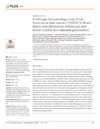Identificador persistente para citar o vincular este elemento:
https://accedacris.ulpgc.es/jspui/handle/10553/45710
| Título: | A retrospective pathology study of two Neotropical deer species (1995-2015), Brazil: Marsh deer (Blastocerus dichotomus) and brown brocket deer (Mazama gouazoubira) | Autores/as: | Navas-Suárez, Pedro Enrique Diaz Delgado, Josue Matushima, Eliana Reiko Fávero, Cintia Maria Sarmiento, Angélica Maria Sánchez Sacristán, Carlos Ewbank, Ana Carolina Joppert, Adriana Marques Duarte, Jose Mauricio Barbanti Dos Santos-Cirqueira, Cinthya Cogliati, Bruno Mesquita, Leonardo Pereira Dos Santos Maiorka, Paulo César Catão-Dias, José Luiz |
Clasificación UNESCO: | 310907 Patología 240118-1 Mamíferos. Ungulados |
Palabras clave: | Retrospective pathology study Deer Neotropical deer Marsh deer Blastocerus dichotomus, et al. |
Fecha de publicación: | 2018 | Publicación seriada: | PLoS ONE | Resumen: | This retrospective study describes the biological and epidemiological aspects, gross and microscopical findings, and most likely causes of death (CD) in two species of Neotropical deer in Brazil. The animals were collected between 1995 and 2015 and represented 75 marsh deer (MD) and 136 brown brocket deer (BBD). Summarized, pneumonia was diagnosed microscopically in 48 MD and 52 BBD; 76 deer suffered trauma, involving dog attack (14 BBD) and vehicle-collision (14 BBD). Pulmonary edema (50 MD; 55 BBD) and congestion (57 MD; 78 BBD) were the most common findings for both species. Additionally, we diagnosed ruminal and myocardial mycosis in MD and BBD, respectively; ovarian dysgerminoma and pancreatic trematodiasis in BBD; and lesions suggestive of malignant catarrhal fever and orbiviral hemorrhagic disease in both species. The main CD in MD was: respiratory (41/75), alimentary, nutritional, trauma and euthanasia (3/75 each). Correspondingly, in BBD were: trauma (34/131), respiratory (30/131) and euthanasia (9/131). Respiratory disease was often defined by pulmonary edema and pneumonia. We provide evidence that respiratory disease, mainly pneumonia, is a critical pathological process in these Neotropical deer species. Although no etiological agents were identified, there is evidence of bacterial and viral involvement. Our results show trauma, mainly anthropogenic, as a common ailment in BBD. We propose to prioritize respiratory disease in future research focused on South American deer health aspects. We believe anthropogenic trauma may be a primary threat for populations of BBD. | URI: | https://accedacris.ulpgc.es/handle/10553/45710 | DOI: | 10.1371/journal.pone.0198670 | Fuente: | PLoS ONE,v. 13 (Y) |
| Colección: | Artículos |
Los elementos en ULPGC accedaCRIS están protegidos por derechos de autor con todos los derechos reservados, a menos que se indique lo contrario.
